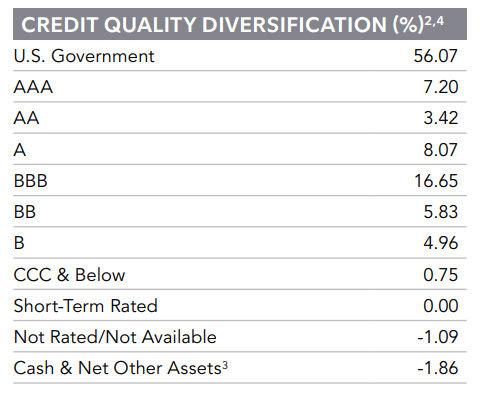As Federal Reserve’s rate hike cycle appears to be nearing its end, bonds are becoming an increasingly attractive investment option. One potential way to play the return of bonds is the Fidelity Total Bond ETF (NYSEARCA:FBND), which offers a diverse portfolio of investment-grade debt securities.
FBND is a fixed-income, actively managed ETF that primarily invests in investment-grade debt securities of various types. The ETF uses the Bloomberg U.S. Universal Bond Index as a guide for its asset allocation strategy, which spans across investment-grade, high-yield, and emerging-market asset classes.
Importantly, FBND aims to maintain an overall interest rate risk similar to that of its benchmark. It also allocates up to 20% of its assets to lower-quality debt securities.
fidelity.com
The ETF Strategy
FBND invests a minimum of 80% of its assets in investment-grade debt securities and repurchase agreements for those securities. The ETF adopts an active management strategy, harnessing a comprehensive analysis of the credit quality of the issuer, the issuer’s potential for success, and the credit, currency, and economic risks associated with the security and its issuer.
FBND’s portfolio is diversified across various sectors, with a significant portion allocated to U.S. Government securities, non-U.S. Government securities, and other government-related (U.S. & non-U.S.) securities. Corporate bonds, Mortgage-Backed Securities (MBS) pass-through, and asset-backed securities (ABS) also form a significant part of the ETF’s portfolio.
fidelity.com
As of September 30, 2023, FBND held 3,068 assets, with the top 5 issuers making up nearly half of the total net assets. These include U.S. Treasury notes, United States Treasury bonds, FNMA guaranteed mortgage pass-through certificates, FNMA/FHLG TBA issuer, and Federal Home Loan Mortgage Corporation – Gold.
As of the end of September 2023, FBND’s 30-Day SEC Yield stood at 5.62%, with a weighted average maturity of 8.60 years and a duration of 5.87 years. When compared to other similar ETFs, FBND holds its ground quite well. For instance, the iShares Core U.S. Aggregate Bond ETF (AGG), and the Vanguard Mortgage-Backed Securities Index ETF (VMBS), all have similar durations to FBND, falling between 6.8 and 7.4.
StockCharts.com
In terms of returns, FBND outperforms VMBS and CORP, but falls short of AGG. However, considering its lower standard deviation, FBND offers a better risk-adjusted return, reflected in its superior Sharpe and Sortino ratios. I do also think that the active management style is a plus for a bond fund like this given the potential to really seek out attractive valuation bond securities.
Conclusion: Is FBND a Viable Investment Opportunity?
Given the probable end of the Federal Reserve’s rate hike cycle and the consequent attractiveness of bonds, FBND presents itself as a viable investment opportunity. It offers a diverse portfolio of investment-grade debt securities, which could be a suitable choice for investors seeking a high level of current income. Moreover, FBND’s active management strategy may offer additional investment opportunities. I think it’s a good fund for a core allocation and certainly makes more sense given the focus on quality and where we are in the cycle for interest rates.
Read the full article here

